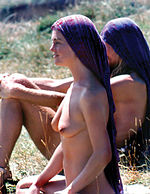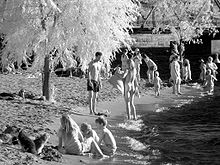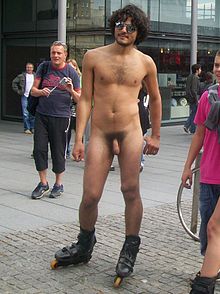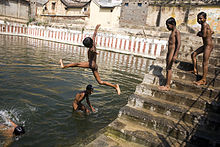- Public nudity
-
Public nudity or nude in public (NIP) refers to nudity not in an entirely private context. It refers to a person appearing nude in a public place or to be seen from a public place. It also includes nudity in a semi-public place, where the general public is free to enter, such as a shopping mall. Nudity in the privacy of a person's home or private grounds or facilities is not public nudity, nor is nudity at privately owned facilities, such as fitness facilities, swimming pools, saunas, or gymnasia, nudist or naturist clubs or resorts, when nudity at those places commonly takes place. Naturism promotes social nudity.
In some cases, public nudity may be legal. For example, there are many countries which have designated public areas as nude beaches, or where nude bathing is unofficially tolerated. In those places, a person would not face legal prosecution or official harassment merely for being nude.
Outside of those areas, community and legal acceptance of public nudity varies considerably. To avoid offending the public in general, public authorities maintain what are sometimes called "standards of decency". What falls outside these standards are usually termed "indecent exposure", or similar terminology. These standards, however, vary with time and place. If the intent is to draw attention to oneself, it may be referred to as exhibitionism, otherwise it may be to draw attention to a cause (see nudity and protest). There are also some people who disrobe in public to attract publicity to themselves, as a career move, such as some streakers at sporting events. There are also others who spontaneously disrobe in public, as an expression of their freedom and the shedding of inhibitions; an example being skinny dipping.
Contents
Legal position
Main article: Indecent exposureWhile it is often accepted western countries that a naked human body is not in itself indecent, the circumstances of its exposure, and any offence caused to others, may be deemed offensive or disorderly.[citation needed] That principle is reflected in depiction of the human form in art of various forms. This is the position, for example, in Germany[1] and Spain, although local laws in the latter country can stipulate that public nudity is either restricted or not permitted. In Barcelona public nudity is regarded as a recognised right, although there have been successful prosecutions for public nudity even there. Associations Addan, the organisation defending the right to nudity, Aleteia and Barcelona Council have published the "Tríptic de Barcelona" that express this and clothes free rights.[2] In the Netherlands public nudity is allowed on sites that have been assigned by the local authorities and other suitable places [3] which effectively means any complaint will cause one to be arrested as a complaint is indication that the place was not "suitable".
On the other hand, it is also recognised that there are large numbers of people who are, for various reasons, offended by and even distressed with displays of nudity. To accommodate these apparently conflicting principles, the courts will intervene only if there is either evidence either of intent to cause offence or to behave indecently, or where such offence is a likely outcome. However, the exact standards of "decency" is subject to local community standards, which vary with time and place, and circumstances. In general, public nudity with any perceived sexual element will be prosecuted, as will one which is considered to be exhibitionist in character, or which involves exposure to children.
In many countries public nudity is forbidden outright on the basis that nudity is inherently sexual. Many states of the United States fine offenders on that basis.[4] (See indecent exposure in the United States.) In many contexts, public nudity has been more accepted, especially at designated areas such as nude beaches and, even in the United States, e.g. during World Naked Bike Ride events or Bay to Breakers. In some states, such as Oregon, public nudity is legal and protected as free speech, as long as there is not the "intent to arouse".
Advocates of the right to be nude
See also: Nudity and protestNot all people who engage in public nudity see themselves as nudists or naturists or belong to traditional naturist or nudist organizations. Several activists, such as Vincent Bethell, claim that associations with naturism or nudism are unnecessary. Others will point out that many people who participate in events such as clothing-optional bike rides or visit clothing-optional beaches do so casually and without association or formal affiliation to groups or movements. Activist Daniel Johnson believes that labels and affiliations overly complicate a relatively simple phenomenon, alienate others from a fear of over-commitment or undesirable stereotypes, and thus get in the way of integrating nudity into everyday life.
Public nudity has sometimes been used to attract more attention to a public protest, a tactic used by the Doukhobors in the early 20th century, and later (particularly from the 1960s onwards) used more widely. Modern slogans include "Disrobe for disarmament", "Nudes, not nukes!", "Naked For Peace", and PETA's "I'd rather go naked than wear fur!".
Formal nudity
Adamites dancing through the streets See also: Clothes free organizations
See also: Clothes free organizationsAlthough ceremony and traditions usually involve dressing up, often with some preferential attire, certain cultural or religious traditions actually prescribe(d) nudity, e.g., in the gymnopaidia or the sect of the Adamites.
This may be symbolic, especially for 'rebirth' to a new life phase, as in the case of baptism (originally taken by an adult, later often as a child - to symbolise the washing away of original sin - and/or at least partially covered up) or certain coming of age rites, such as cow jumping by young men of the East African Hamer people before they are eligible for marriage. Another example is the neo-pagan tradition in some Wiccan covens of going skyclad for certain rituals.
In other cases, the physical exposure is a functional part testing endurance, e.g., to undergo scarification, as among various Australian Aboriginal and Sepik River tribes in New Guinea.
Artistic expression
 Topless modeling: Fashion line Imitation of Christ incorporated toplessness in its fashion show, which brought comparisons to Vanessa Beecroft's art.[5]
Topless modeling: Fashion line Imitation of Christ incorporated toplessness in its fashion show, which brought comparisons to Vanessa Beecroft's art.[5]
 NakedBerlin - Group of men among hundreds of tourists at Berlin’s Brandenburg Gate; photographed by Team Henning von Berg/Marco.
NakedBerlin - Group of men among hundreds of tourists at Berlin’s Brandenburg Gate; photographed by Team Henning von Berg/Marco. Main article: Nudity in art
Main article: Nudity in artNudity has at all times been an aspect of art. Contemporary art has extended the use of nudity to non-conventional forms.
- Spencer Tunick is best-known for photographing installations that feature large numbers of nude people (up to 18,000) posed in artistic formations. In these formal images, the nude form becomes abstract due to the sheer number of people so closely placed together. For Tunick, the individual naked body is not important; it is the big group which becomes a "living sculpture" in the landscape.
- San Francisco Bay area photographer Jack Gescheidt is staging his events as part of an ongoing series, called "The Tree Spirit Project".
- The photography of Paul Harvey whose book The Spirit of Lady Godiva depicts nude models in urban environments.
- The films of Charles MacFarland are featuring naked people in social settings. Locations include international naturist resorts and beaches.
- Photographer Henning von Berg directs whimsical art happenings with small groups of completely naked people in public urban locations around the globe. While placing a few nude women and men at crowded landmarks in downtown metropolises, he is searching to capture the inter-action between the naked amateur models and the thousands of very surprised passers-by.[6] Von Berg also organized the world’s only-ever male nude photo shoot inside a parliament building, while hundreds of speechless people surrounded the group of six amateur models.[7]
Recreation and sport
See also: Nudity in sport and Nude recreationCertain activities in public areas are more readily accepted to be done while naked, such as sun bathing and swimming. Everyday activities such as riding a train or bus, shopping, or attending school or work are almost never considered by the public to be appropriate without clothing.
Examples include going nude swimming at hot springs, nude beaches, naked hiking, streaking and even roller skating. Sandy Snakenberg has organized nude skating and rollerblading events in San Francisco, the largest of their kind in the world. Nude beaches are found in many Western countries.
In recent times, it appears that public nudity is becoming more common with nude sporting and other activities being held. These include naked hiking, canuding (nude canoeing), the World Naked Bike Ride, Bay to Breakers, Solstice Cyclists. No general public outcry has accompanied these events.
- Clothing-optional bike rides
Nudity in religion
 People at Nambassa, 1978
People at Nambassa, 1978 See also: Nudity in religion
See also: Nudity in religionThe Adamites, an early Christian sect, practiced "holy nudism", lived in absolute lawlessness and stripped themselves naked while engaged in common worship. During the Middle Ages, the doctrines of this obscure sect were revived: in the Netherlands by the Brethren of the Free Spirit and the Taborites in Bohemia, and, in a grosser form, by the Beghards in Germany. Everywhere, they met with firm opposition from the mainstream churches.[8]
Digambara monks in India reject any form of clothing whatsoever and live naked, or 'sky clad'. Digambara is one of the two main sects of Jainism.[9]
The term skyclad is also used referring to ritual nudity in the context of Neopagan belief systems, specifically Wicca.
Sexual public nudity
Public nudity can be regarded as either sexual or non-sexual in nature.
Some people regard flashing, streaking and mooning as indecent exposure and as sexual public nudity. Similarly, some people regard dogging, exhibitionism, and voyeurism as offensive behaviour.
Burning Man camps range from non-sexual nudity to overtly sexually themed, while the Folsom Street Fair held in San Francisco is a leather and BDSM themed fair.[10]
Aspects of the Nambassa hippie festivals held in New Zealand in the 1970's are regarded as non-sexual naturism. For example, of the 75,000 patrons who attended the 1979 Nambassa 3-day counterculture festival, an estimated 35% spontaneously chose to remove their clothing,[11] preferring complete or part nudity.[12]
See also
- History of nudity
- Timeline of significant non-sexualized public nudity activities
- Public sex
- Intimate parts
- Topfreedom advocates gender equality and the right of women to choose to go topfree where men can.
- Bohemianism and Counterculture
- Culture jamming and Direct action and Flash mob and Smart mob
- Nudity in combat
- Nudism
- Public display of affection
References
- ^ See German position (German)
- ^ addan. Associació per a la Defensa del Dret a la Nuesa. - Asociacion para la defensa del derecho al desnudo
- ^ Nudity and the law
- ^ Vermont does not have a state law against nudity in public
- ^ Imitation of Christ Runway Review, Laird Borelli, Style.com, September 17, 2002.
- ^ NAKED BERLIN – NAKED SYDNEY.
- ^ NAKED BERLIN – The Liberal Capital
- ^ Adamites, Catholic Encyclopedia
- ^ BBC - Religion & Ethics - Jain sects
- ^ Burning Man nudity
- ^ Public nudity at Nambassa
- ^ Nambassa: A New Direction, edited by Colin Broadley and Judith Jones, A. H. & A. W. Reed, 1979. ISBN 0-589-01216-9
Further reading
- The Offense of Public Nudity by Mark Storey
- Naturism and Civil Disobedience by Mark Storey
- Nude & Natural 20.4 Summer 2001. Article by Jim Meyer on TFTBY titled Vincent's Vision: Is Vincent Bethell a menace to decent society? Or the best thing to happen to naturism in years?. Includes an interview with Vincent Bethell. Seven pages with ten pictures.
- Nude & Natural 21.2 Winter 2002. The Bethell Approach: A Protest Colloquy/The Bethell Approach: Is the Time for Mass Nude Protests Upon Us? Includes statements by Vincent Bethell, Mark Nisbet, Cec Cinder, Paul Rapoport, Les Rootsey, Morley Shloss, T.A. Wyner, and Mark Storey. Eight Pages, four pictures. Briefly Noted Vincent Victorious.
- Nude & Natural Vol 21.3: 24–28, Spring 2002.Terri Sue Webb: An American Bethell/Beyond Safe Havens: Oregon's Terri Sue Webb (written by Daniel Johnson).
- Nude & Natural Vol 23.4: 73, Summer 2004.Takin' It to the Streets: The Cutting Edge of Naturism by Mark Storey. Mark claims "The future of naturism is on public lands. To gain naturist freedoms on public lands will require getting naked in public".
- Nude & Natural magazine issues 12.2, 12.3, 13.1 for coverage of Andrew Martinez
External links
Categories:- Civil disobedience
- Clothing-optional events
- Clothing-free events
- Culture jamming
- Public nudity
Wikimedia Foundation. 2010.






